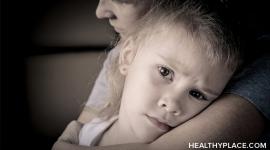References to Reactive Attachment Disorder
What is Reactive Attachment Disorder (RAD)?
American Psychiatric Association. (2013). Diagnostic and statistical manual of mental disorders, Fifth edition (DSM-5). Washington, D.C: American Psychiatric Publishing.
Kronenberger, W.G. & Meyer, R.G. (2001). The child clinician’s handbook, 2nd edition. Needham Heights, MA: Pearson Allyn & Bacon.
Liotti, G. (1999). Disorganization of attachment as a model for understanding dissociative Psychopathology. In Solomon, J. & George, C. (Eds.), Attachment disorganization. New York: Guilford Press.
Seligman, L. (1998). Selecting effective treatments: A comprehensive, systematic guide to treating mental disorders, Revised edition. San Francisco: Jossey-Bass.
Signs & Symptoms of Reactive Attachment Disorder. (2015). Retrieved December 26, 2015, from http://www.obhhospital.com/disorders/reactive-attachment/causes-signs-symptoms
Reactive Attachment Disorder (RAD) Symptoms
American Psychiatric Association. (2013). Diagnostic and statistical manual of mental disorders, Fifth edition (DSM-5). Washington, D.C: American Psychiatric Publishing.
Harris, C.A. (2007). “Why does she behave this way?” Reactive attachment disorder. In Hobson
Dugger, S.M. & Carlson, L.A. (Eds.), Critical incidents in counseling children. Alexandria, VA: American Counseling Association.
Kronenberger, W.G. & Meyer, R.G. (2001). The child clinician’s handbook, 2nd edition. Needham Heights, MA: Pearson Allyn & Bacon.
Signs & Symptoms of Reactive Attachment Disorder. (2015). Retrieved December 26, 2015, from http://www.obhhospital.com/disorders/reactive-attachment/causes-signs-symptoms.
Thompson, C.L. (2007). Response. In Hobson Dugger, S.M. & Carlson, L.A. (Eds.), Critical incidents in counseling children. Alexandria, VA: American Counseling Association.
Effects of Reactive Attachment Disorder in Teens, Children
American Psychiatric Association. (2013). Diagnostic and statistical manual of mental disorders, Fifth edition (DSM-5). Washington, D.C: American Psychiatric Publishing.
Haugaard, J.J. & Hazan, C. (2004). Recognizing and treating uncommon behavioral and emotional disorders in children and adolescents who have been severely maltreated: Reactive attachment disorder. Child Maltreatment, 9(2), 154-160.
Kronenberger, W.G. & Meyer, R.G. (2001). The child clinician’s handbook, 2nd edition. Needham Heights, MA: Pearson Allyn & Bacon.
Signs & Symptoms of Reactive Attachment Disorder. (2015). Retrieved December 26, 2015, from http://www.obhhospital.com/disorders/reactive-attachment/causes-signs-symptoms
Reactive Attachment Disorder in Adults
American Psychiatric Association. (2013). Diagnostic and statistical manual of mental disorders, Fifth edition (DSM-5). Washington, D.C: American Psychiatric Publishing.
Haugaard, J.J. & Hazan, C. (2004). Recognizing and treating uncommon behavioral and emotional disorders in children and adolescents who have been severely maltreated: Reactive attachment disorder. Child Maltreatment, 9(2), 154-160.
Kronenberger, W.G. & Meyer, R.G. (2001). The child clinician’s handbook, 2nd edition. Needham Heights, MA: Pearson Allyn & Bacon.
Liotti, G. (1999). Disorganization of attachment as a model for understanding dissociative Psychopathology. In Solomon, J. & George, C. (Eds.), Attachment disorganization. New York: Guilford Press.
Reactive Attachment Disorder in Adults. (2014). Retrieved December 26, 2015, from http://www.newhealthadvisor.com/Reactive-Attachment-Disorder-in-Adults.html
Seligman, L. (1998). Selecting effective treatments: A comprehensive, systematic guide to treating mental disorders, Revised edition. San Francisco: Jossey-Bass.
Signs & Symptoms of Reactive Attachment Disorder. (2015). Retrieved December 26, 2015, from http://www.obhhospital.com/disorders/reactive-attachment/causes-signs-symptoms
Reactive Attachment Disorder (RAD) Treatment
American Psychiatric Association. (2013). Diagnostic and statistical manual of mental disorders, Fifth edition (DSM-5). Washington, D.C: American Psychiatric Publishing.
Harris, C.A. (2007). “Why does she behave this way?” Reactive attachment disorder. In Hobson Dugger, S.M. & Carlson, L.A. (Eds.), Critical incidents in counseling children. Alexandria, VA: American Counseling Association.
Haugaard, J.J. & Hazan, C. (2004). Recognizing and treating uncommon behavioral and emotional disorders in children and adolescents who have been severely maltreated: Reactive attachment disorder. Child Maltreatment, 9(2), 154-160.
Kronenberger, W.G. & Meyer, R.G. (2001). The child clinician’s handbook, 2nd edition. Needham Heights, MA: Pearson Allyn & Bacon.
Liotti, G. (1999). Disorganization of attachment as a model for understanding dissociative
Psychopathology. In Solomon, J. & George, C. (Eds.), Attachment disorganization. New York: Guilford Press.
Seligman, L. (1998). Selecting effective treatments: A comprehensive, systematic guide to treating mental disorders, Revised edition. San Francisco: Jossey-Bass.
Thompson, C.L. (2007). Response. In Hobson Dugger, S.M. & Carlson, L.A. (Eds.), Critical
incidents in counseling children. Alexandria, VA: American Counseling Association.
Parenting a Child with Reactive Attachment Disorder
Harris, C.A. (2007). “Why does she behave this way?” Reactive attachment disorder. In Hobson Dugger, S.M. & Carlson, L.A. (Eds.), Critical incidents in counseling children. Alexandria, VA: American Counseling Association.
Haugaard, J.J. & Hazan, C. (2004). Recognizing and treating uncommon behavioral and emotional disorders in children and adolescents who have been severely maltreated: Reactive attachment disorder. Child Maltreatment, 9(2), 154-160.
Kronenberger, W.G. & Meyer, R.G. (2001). The child clinician’s handbook, 2nd edition. Needham Heights, MA: Pearson Allyn & Bacon
Parenting Children & Teens with Reactive Attachment Disorder. (n.d.). Retrieved December 23, 2015, from http://www.reactiveattachment-disorder.com/2009/07/parenting-children-with-reactive.html
Seligman, L. (1998). Selecting effective treatments: A comprehensive, systematic guide to treating mental disorders, Revised edition. San Francisco: Jossey-Bass.
Thompson, C.L. (2007). Response. In Hobson Dugger, S.M. & Carlson, L.A. (Eds.), Critical incidents in counseling children. Alexandria, VA: American Counseling Association.
What is Disinhibited Social Engagement Disorder?
American Psychiatric Association. (2013). Diagnostic and statistical manual of mental disorders, Fifth edition (DSM-5). Washington, D.C: American Psychiatric Publishing.
Harris, C.A. (2007). “Why does she behave this way?” Reactive attachment disorder. In Hobson
Dugger, S.M. & Carlson, L.A. (Eds.), Critical incidents in counseling children. Alexandria, VA: American Counseling Association.
Haugaard, J.J. & Hazan, C. (2004). Recognizing and treating uncommon behavioral and emotional disorders in children and adolescents who have been severely maltreated: Reactive attachment
disorder. Child Maltreatment, 9(2), 154-160.
Kronenberger, W.G. & Meyer, R.G. (2001). The child clinician’s handbook, 2nd edition. Needham Heights, MA: Pearson Allyn & Bacon.
Seligman, L. (1998). Selecting effective treatments: A comprehensive, systematic guide to treating mental disorders, Revised edition. San Francisco: Jossey-Bass.
APA Reference
Peterson, T.
(2018, October 24). References to Reactive Attachment Disorder, HealthyPlace. Retrieved
on 2025, November 19 from https://www.healthyplace.com/ptsd-and-stress-disorders/reactive-attachment-disorder/references-to-reactive-attachment-disorder


